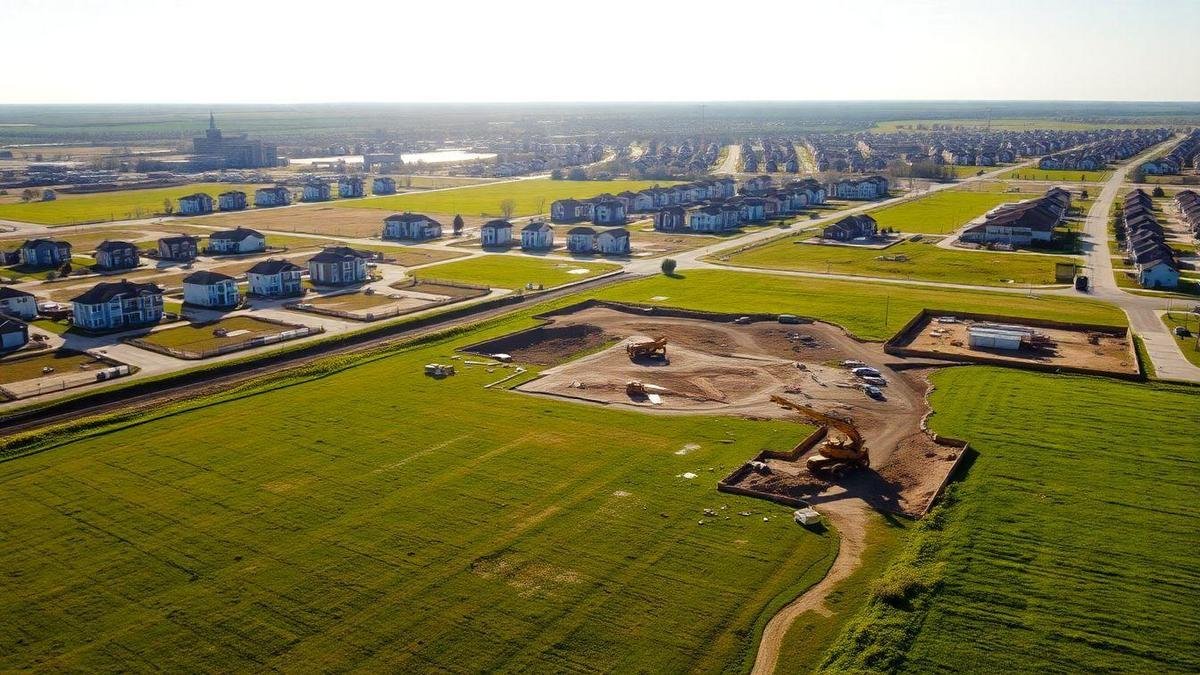ROI land development in the US is a key focus for investors seeking to maximize their returns. This article will explore the importance of understanding ROI in land development, highlighting key metrics and trends. It will also cover sustainable investments, strategies for high returns, and the role of technology in shaping the future of land development. Investors will gain insights into legal considerations, financing options, and common pitfalls to avoid. Overall, this guide aims to provide a comprehensive overview of the opportunities within the US land development landscape.
Key Takeaways on ROI Land Development in the US for Investors
- Land development can offer good returns for investors.
- Investors should research location trends carefully, particularly in popular states for land development.
- Proper zoning is important for successful projects; understanding zoning laws is essential.
- Timing the market can affect investment success.
- Building strong partnerships can enhance development efforts.

Understanding ROI Land Development in the US
Definition of ROI in Land Development
ROI, or Return on Investment, in land development refers to the gain or loss made from an investment relative to the amount of money invested. In simpler terms, it measures how much profit an investor can expect from their investment in land. For example, if an investor buys a piece of land for $100,000 and later sells it for $150,000, the ROI would be 50%. This calculation helps investors determine whether a project is worth their time and money.
Importance of ROI for Investors
Understanding ROI is crucial for investors. It serves as a compass, guiding them through their investment decisions. By focusing on ROI, investors can:
- Evaluate Projects: Compare different land development projects to see which one offers the best returns.
- Make Informed Decisions: Decide where to allocate resources for maximum gain.
- Assess Risk: A higher ROI often indicates a more profitable investment, but it can also reflect higher risk. Knowing this helps investors weigh their options.
Key Metrics for Measuring ROI
Investors can use several key metrics to measure ROI effectively. Here are a few:
| Metric | Description |
|---|---|
| Net Profit | Total revenue minus total costs. |
| Investment Cost | Total money spent on the project. |
| ROI Percentage | (Net Profit / Investment Cost) x 100. |
| Cap Rate | Net Operating Income / Current Market Value. |
These metrics provide a clearer picture of the potential success of a land development project. For instance, a high Cap Rate often indicates a good investment opportunity, while a low Net Profit might signal the need for further analysis.

Current Trends in US Land Investment
Popular Areas for Land Development
In the United States, certain regions have become hotspots for land development. For investors, understanding these areas is crucial. Texas, for instance, continues to attract attention. With its vast land and business-friendly environment, it’s a prime choice for many looking to invest. Florida is another popular choice, especially for those interested in residential and vacation properties. The growing population and tourism make it a lucrative option.
Here’s a quick overview of some popular areas:
| State | Key Features |
|---|---|
| Texas | Business-friendly, large land areas |
| Florida | High tourism, growing population |
| California | Tech hub, diverse opportunities |
| Arizona | Affordable land, growing cities |
Emerging Markets in Real Estate Investment
Emerging markets are where investors are finding new opportunities. States like North Carolina and Georgia are gaining traction. They offer affordable land and a growing economy. In addition, cities like Austin and Atlanta are seeing a surge in demand for both commercial and residential properties. Investors are keen on these areas due to their potential for growth and positive economic indicators.
Factors Driving Land Investment Trends
Several factors are influencing land investment trends in the U.S. Here are the main ones:
- Population Growth: More people mean a higher demand for housing and services.
- Economic Development: Areas with new businesses and jobs attract investors.
- Infrastructure Improvements: Better roads, schools, and hospitals make areas more appealing.
- Technological Advancements: Innovations in construction and land management are creating new opportunities.
Investors are always on the lookout for the next big thing. ROI land development in the US is a key focus, as they want to maximize their returns. Understanding these trends and factors can help them make informed decisions.

Sustainable Land Investments and Their Benefits
What Makes Land Development Sustainable?
Sustainable land development focuses on responsible use of resources. It aims to meet the needs of the present without compromising future generations. Key aspects include:
- Environmental Protection: This means preserving natural habitats and reducing pollution.
- Community Engagement: Involving local communities in decision-making helps ensure that projects meet their needs.
- Economic Viability: Sustainable projects should also be financially sound, providing returns for investors.
Long-term Benefits of Sustainable Investments
Investing in sustainable land development offers several long-term benefits:
- Increased Property Value: Sustainable projects often attract higher demand, boosting property values over time.
- Lower Operational Costs: Green buildings can lead to savings on energy and water bills.
- Enhanced Reputation: Investors gain a positive image by supporting eco-friendly initiatives, which can attract more clients.
Examples of Sustainable Land Projects
| Project Name | Location | Key Features |
|---|---|---|
| The Bullitt Center | Seattle, WA | Uses solar panels and rainwater systems |
| Bosco Verticale | Milan, Italy | Vertical gardens promoting biodiversity |
| The Eden Project | Cornwall, UK | Focuses on conservation and education |
These projects showcase how sustainable land development can be both innovative and profitable. They serve as blueprints for future developments, emphasizing the importance of environmental stewardship.

Strategies for High ROI Land Projects
Identifying High ROI Opportunities
Finding high ROI opportunities in land development requires a sharp eye and an understanding of market trends. Investors should look for areas with growing populations, increasing demand for housing, or upcoming infrastructure projects. These factors often signal potential for substantial returns.
- Research Local Markets: Analyze demographics and economic indicators, utilizing tools like market analysis tools.
- Check Zoning Regulations: Understand what can be built on the land by consulting zoning guides.
- Network with Local Experts: Engage with real estate agents and developers who know the area well.
Planning and Execution for Maximum Returns
Once an opportunity is identified, the next step is to create a solid plan. This involves not just the design of the project but also a strategy for execution.
- Set Clear Goals: What does success look like? Define measurable objectives.
- Budget Wisely: Keep track of all expenses to avoid overspending.
- Engage Stakeholders: Involve local authorities and community members early in the process.
| Step | Action Required |
|---|---|
| Planning | Define project scope and timeline |
| Execution | Implement the plan with regular check-ins |
| Review | Analyze outcomes against initial goals |
Risk Management in Land Development
Risk management is essential in land development. Investors must be prepared for setbacks and challenges that may arise during the project.
- Conduct Thorough Research: Understand potential risks, such as environmental issues or market fluctuations.
- Diversify Investments: Spread investments across different projects to minimize risk.
- Have a Contingency Plan: Prepare for unexpected costs or delays.

Real Estate ROI Analysis for Investors
Tools for Analyzing Real Estate ROI
Investors today have a variety of tools at their disposal for analyzing ROI in land development in the US. These tools can help them make informed decisions. Some popular tools include:
- Spreadsheet Software: Programs like Microsoft Excel allow investors to create custom models for their specific needs.
- Real Estate Investment Software: Platforms such as REI Wise or PropertyMetrics provide built-in calculators and templates for quick ROI analysis.
- Online Calculators: Many websites offer free ROI calculators that can give investors a quick idea of potential returns.
These tools streamline the analysis process, making it easier for investors to assess the financial viability of their projects.
Importance of Data in Investment Decisions
Data plays a crucial role in investment decisions. Investors must rely on accurate and up-to-date information to make sound choices. Here are a few reasons why data is essential:
- Market Trends: Understanding current market trends helps investors identify profitable opportunities.
- Property Valuation: Accurate data on property values ensures investors do not overpay.
- Risk Assessment: Data helps in evaluating potential risks associated with a particular investment.
Incorporating data into their strategies can significantly enhance an investor’s chances of success.
Common Mistakes in ROI Analysis
Even seasoned investors can make mistakes when analyzing ROI. Here are some common pitfalls to avoid:
- Ignoring Hidden Costs: Failing to account for expenses like maintenance, property taxes, and insurance can lead to inflated ROI figures.
- Overestimating Rental Income: Investors may project unrealistic rental income, skewing their ROI calculations.
- Neglecting Market Research: Skipping thorough market research can result in poor investment choices.
By recognizing these mistakes, investors can refine their analysis and improve their overall investment strategy.

Land Development Opportunities for Global Investors
How Global Investors Can Enter the US Market
Global investors looking to tap into the US market can start by understanding the local regulations and market conditions. They should consider forming partnerships with local developers or real estate firms. This approach provides valuable insights and access to established networks.
Investors can also attend real estate conferences and trade shows. These events offer a chance to meet industry professionals and learn about the latest trends. Additionally, online platforms are available for research and networking.
Key Steps for Entry:
- Research: Study the local market and regulations, which can be found in resources like guides for foreign investors.
- Network: Connect with local developers and real estate experts.
- Attend Events: Participate in conferences and trade shows.
- Utilize Online Resources: Use platforms for research and networking.
Benefits of Investing in US Land Development
Investing in land development in the US offers several advantages. The country has a strong economy, making it a stable place for investment. With a growing population, demand for housing and commercial spaces continues to rise.
Moreover, the US market provides diverse opportunities. Investors can choose from residential, commercial, or mixed-use developments. This flexibility allows them to align their investments with personal goals.
Benefits Overview:
| Benefit | Description |
|---|---|
| Economic Stability | Strong and resilient economy |
| Growing Demand | Increasing need for housing and commercial spaces |
| Diverse Opportunities | Options in residential, commercial, and mixed-use |
Case Studies of Successful Global Investments
Several global investors have seen significant returns by investing in US land development. For instance, a Chinese firm invested in a major apartment complex in California. This project not only provided housing but also revitalized the neighborhood, leading to increased property values.
Another example is a European investment group that developed a mixed-use project in Texas. This venture attracted businesses and residents alike, showcasing the potential for high returns.
These case studies illustrate that with the right strategy, global investors can achieve substantial ROI in land development in the US.

The Role of Technology in Land Development
Innovations Shaping Land Development
In today’s fast-paced environment, technology plays a pivotal role in land development. New innovations are transforming how projects are planned and executed. For instance, drones are now used for surveying land, providing accurate data quickly. This not only saves time but also reduces costs.
3D modeling software allows developers to visualize projects before any physical work begins. This technology helps in making informed decisions, which is crucial for investors. Furthermore, geographic information systems (GIS) provide valuable insights into land use, helping to identify the best locations for development.
Technology’s Impact on ROI Land Development
The use of technology directly impacts the ROI (Return on Investment) in land development in the US. By implementing advanced tools, developers can streamline processes, minimize delays, and cut unnecessary expenses. For example, using automated project management software helps in tracking progress and budgets, ensuring that projects stay on schedule.
A recent study found that projects utilizing modern technology experienced a 20% increase in ROI compared to those that relied on traditional methods. This statistic highlights the importance of integrating technology for better financial outcomes.
| Technology Type | Impact on ROI (%) |
|---|---|
| Drones | 15% |
| 3D Modeling | 20% |
| GIS | 25% |
| Automated Management Tools | 30% |
Future Trends in Land Development Technology
Looking ahead, several trends are set to shape the future of land development. Artificial Intelligence (AI) is expected to play a significant role in predicting market trends and consumer needs. This can help developers make more strategic decisions, ultimately enhancing their projects’ success.
Sustainable technologies are also gaining traction. With increasing awareness of environmental issues, more developers are focusing on eco-friendly solutions. This shift not only meets regulatory demands but also attracts investors who prioritize sustainability.
In summary, technology is not just a tool; it is a game-changer in the land development sector. As innovations continue to emerge, staying updated will be crucial for investors aiming for success.

Financing Options for Land Development Projects
Traditional vs. Alternative Financing Methods
When it comes to financing land development projects, investors often face a choice between traditional and alternative financing methods. Traditional financing typically involves banks or credit unions that offer loans based on the project’s feasibility and the investor’s creditworthiness. These loans often come with strict requirements, making them less accessible for some developers.
On the other hand, alternative financing options have emerged as viable solutions. Crowdfunding, for example, allows multiple investors to pool their resources for a project. This method can be particularly appealing for those looking to diversify their investment portfolio. Additionally, private equity firms and venture capitalists may provide funding in exchange for a share of the profits.
| Financing Method | Description | Pros | Cons |
|---|---|---|---|
| Traditional Loans | Loans from banks or credit unions | Established process, lower interest rates | Strict requirements, lengthy approval |
| Crowdfunding | Pooling funds from multiple investors | Access to a larger pool of funds | Uncertain funding success |
| Private Equity | Investment from firms in exchange for equity | Potential for large capital infusion | Loss of control over the project |
| Venture Capital | Funding from investors seeking high returns | Access to expertise and networks | High expectations for ROI |
Understanding the Costs Involved
Understanding the costs involved in land development is crucial for any investor. Costs can vary widely based on location, project scope, and market conditions. Key expenses include land acquisition, construction costs, permits, and ongoing maintenance.
Investors must also consider hidden costs such as environmental assessments, legal fees, and financing costs. A well-rounded budget should account for these factors to avoid financial pitfalls.
Tips for Securing Funding for Land Projects
Securing funding for land projects can be challenging, but there are strategies that can help. Here are some tips:
- Create a Solid Business Plan: A detailed plan that outlines the project’s goals, timeline, and financial projections can attract potential investors.
- Build Relationships: Networking with industry professionals can open doors to funding opportunities. Attend conferences and local meetups to connect with others in the field.
- Showcase Your Expertise: Highlighting past successes and relevant experience can instill confidence in potential investors.
- Be Transparent: Clearly communicate the risks and benefits to investors. Honesty fosters trust and can lead to better funding opportunities.

Legal Considerations in US Land Development
Zoning Laws and Regulations
Zoning laws play a crucial role in land development across the United States. These laws dictate how land can be used in certain areas. They can affect everything from residential housing to commercial buildings. For investors, understanding these laws is essential, as they can significantly impact the ROI of land development in the US. Familiarizing oneself with zoning regulations can aid in this process.
Zoning regulations often include:
- Residential Zones: Areas designated for homes.
- Commercial Zones: Spaces for businesses and retail.
- Industrial Zones: Locations for factories and warehouses.
Investors should familiarize themselves with local zoning codes. Each city or county may have different rules that can influence their development plans.
Navigating Permits and Approvals
Getting the right permits and approvals is a vital step in the land development process. Without these, no construction can begin. The process can be lengthy and often requires patience.
Investors typically need to secure several types of permits, including:
- Building Permits: Required for any construction.
- Environmental Permits: Necessary if the land impacts the environment.
- Site Plan Approvals: Needed to show how the land will be developed.
It’s wise for investors to work closely with local authorities. This can help speed up the approval process and avoid potential roadblocks.
Common Legal Challenges for Investors
Investors may face various legal challenges during land development. Here are some common issues:
| Challenge | Description |
|---|---|
| Zoning Disputes | Conflicts can arise if the proposed use does not align with zoning laws. |
| Environmental Regulations | Compliance with environmental laws can lead to delays or additional costs. |
| Property Rights Issues | Disputes with neighboring property owners can complicate development. |
Understanding these challenges can prepare investors for potential setbacks. Being proactive can save time and money in the long run.
In the End…
ROI land development in the US stands as a significant opportunity for investors aiming to maximize their returns. By grasping the intricacies of key metrics, current trends, and sustainable practices, investors can navigate the complex landscape of land development with confidence. The importance of technology and financing options cannot be overstated, as they play pivotal roles in enhancing project outcomes and ensuring financial viability.
As investors embark on this journey, they must remain vigilant of legal considerations and potential pitfalls that could hinder their success. By leveraging insights from this comprehensive guide, investors can make informed decisions that align with their financial goals and contribute positively to the communities they engage with.
For those eager to delve deeper into the world of land development and uncover more strategies for success, further exploration awaits at Land Development Hub.
Eduardo Bugallo, PhD.

No responses yet